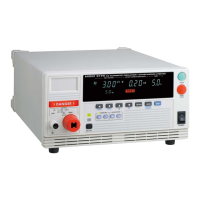9.3 Communication Methods
134
Standard Event Status Register (SESR)
The Standard Event Status Register is an 8-bit register.
If any bit in the Standard Event Status Register is set to 1 (after masking by the
Standard Event Status Enable Register), bit 5 (ESB) of the Status Byte Register
is set to 1.
The Standard Event Status Register is cleared in the following situations:
• When a
∗CLS command is executed
• When an event register query (
∗ESR?) is executed
• When the instrument is powered on
9.3.4 Event Registers
Bit 7 PON
Power-On Flag
Set to 1 when the power is turned on, or upon recovery from an outage.
Bit 6 URQ unused
Bit 5 CME
Command error.
(The command to the message terminator is ignored.)
This bit is set to 1 when a received command contains a syntactic or seman-
tic error:
• Program header error
• Incorrect number of data parameters
• Invalid parameter format
• Received a command not supported by the instrument
Bit 4 EXE
Execution Error
This bit is set to 1 when a received command cannot be executed for some
reason.
• The specified data value is outside of the set range
• The specified setting data cannot be set
Bit 3 DDE
Device-Dependent Error
This bit is set to 1 when a command cannot be executed due to some rea-
son other than a command error, a query error or an execution error.
• Execution is impossible due to an internal instrument fault
Bit 2 QYE
Query Error (the output queue is cleared)
This bit is set to 1 when a query error is detected by the controller of the out-
put queue.
• When an attempt has been made to read an empty output queue (GP-IB
only)
• When the data overflows the output queue
• When data in the output queue is lost
Bit 1 RQC unused
Bit 0 OPC unused

